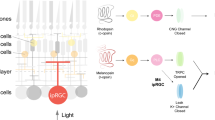Abstract.
In all vertebrates melatonin is rhythmically synthesised in the pineal gland and functions as a hormonal message encoding for the duration of darkness. This review focuses on the role of melatonin in the circadian organisation of mammals by comparing signal transduction mechanisms in the pineal organ, the suprachiasmatic nucleus and the hypophyseal pars tuberalis in melatonin-proficient (C3H) and melatonin-deficient (C57BL) mice strains. Surprisingly, the major signal transduction cascades in the pineal organ did not differ between the two mouse strains. With regard to the suprachiasmatic nucleus, the site of the endogenous clock, it was found that melatonin at most sets the gain for clock error signals mediated via the retinohypothalamic tract, but has no effect on the rhythm generation itself or on the maintenance of the oscillation. In contrast, melatonin plays an essential role in the control of the hypophyseal pars tuberalis. Here it acts in concert with adenosine to elicit rhythms in clock gene expression. Melatonin opens a temporally restricted gate for adenosine to induce cyclic AMP (cAMP)-sensitive genes by sensitising the adenylyl cyclase. This interaction, which grants a temporally precise regulation of gene expression, may reflect the central role of melatonin, i.e. in synchronising peripheral clock cells that require unique phasing of output signals with the master clock in the brain.
Similar content being viewed by others
Author information
Authors and Affiliations
Additional information
Electronic Publication
Rights and permissions
About this article
Cite this article
Stehle, J.H., von Gall, C. & Korf, HW. Organisation of the circadian system in melatonin-proficient C3H and melatonin-deficient C57BL mice: a comparative investigation. Cell Tissue Res 309, 173–182 (2002). https://doi.org/10.1007/s00441-002-0583-2
Received:
Accepted:
Published:
Issue Date:
DOI: https://doi.org/10.1007/s00441-002-0583-2




